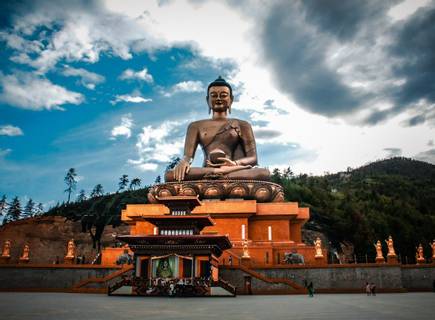Gewogs & Dzongkhags
A gewog is a group of villages and a Dzongkhag is one of 20 local districts in Bhutan. Much like a township and a county.
The Trans Bhutan Trail crosses 12 mountain passes and a rich mosaic of 27 Gewogs running through nine dzongkhags and covering 403 kilometres (250 miles) from Haa in the west to Trashigang in the east.
Katsho (Haa)
Elevation Change along the Trail: 250 m (821 ft)
Population: 1,500
This is one of the smallest gewogs in Haa with 11 villages. People of Katsho grow cereals, fruits, and vegetables to supplement their income, and rear yaks and cattle for their livelihood.
Lamgong (Paro)
Elevation Change along the Trail: 2,165 m (7,103 ft)
Population: 5,000
Close to four square kilometres (1.5 square miles) of this gewog are under forest cover. The main cash crop in Lamgong is apples, and the community is also known for its red rice and aromatic small grain rice varieties.
Dopshari (Paro)
Elevation Change along the Trail: 2,165 m (7,103 ft)
Population: 3,180
Agriculture is the major economic activity of this gewog, including wheat, potato, apple, and dairy farming. Dungtse Lhakhang, a small three storied temple located in Jangsa village, is one of the most visited religious places in the gewog.
Chang (Thimphu)
Elevation Change along the Trail: 1,720 m (5,643 ft)
Population: 6,000
Located within the capital city of Thimphu, this is one of the most developed gewogs in the country. People in Chang earn their living through a combination of agriculture and business.
Dopshari (Paro)
Elevation Change along the Trail: 2,165 m (7,103 ft)
Population: 3,180
Agriculture is the major economic activity of this gewog, including wheat, potato, apple, and dairy farming. Dungtse Lhakhang, a small three storied temple located in Jangsa village, is one of the most visited religious places in the gewog.
Chang (Thimphu)
Elevation Change along the Trail: 1,720 m (5,643 ft)
Population: 6,000
Located within the capital city of Thimphu, this is one of the most developed gewogs in the country. People in Chang earn their living through a combination of agriculture and business.
Mewang (Thimphu)
Elevation Change along the Trail: 1,958 m (6,424 ft)
Population: 7,806
With 44 separate villages, Mewang is the largest gewog in Thimphu Dzongkhag. It is home to people from diverse cultural backgrounds, including people from across Bhutan and some Tibetans. Agriculture is the main source of income in this gewog, which is the largest producer of asparagus in the country.
Toeb (Punakha)
Elevation Change along the Trail: 1,491 m (4,892 ft) Population: 1,300 Toeb sits alongside the national highway and is the smallest gewog in Punakha. People from Toeb rely on rice paddies for their livelihood, and many also sell fruits and vegetables along the highway.
Talog (Punakha)
Elevation Change along the Trail: 1,300 m (4,265 ft)
Population: <500
This gewog is one of the smallest but most culturally diverse in Punakha with inhabitants from all across Bhutan. This is also the ancestral village of the Queen Mother, Ashi Dori Wangmo Wangchuck.
Dzomi (Punakha)
Elevation Change along the Trail: 1,200 m (3,937 ft)
Population: 2,000
Like many gewogs in the area, the people of Dzomi depend largely on agriculture and crop cultivation. Dzomi is particularly celebrated for its high quality breeds of livestock.
Guma (Punakha)
Elevation Change along the Trail: 156 m (512 ft)
Population: 4,200
Guma is one of the most densely populated gewogs, and has the highest number of villages in the Punakha Dzongkhag. Most people in Guma depend on agriculture. It is one of the main producers of chillies in the country, and, thanks to its favourable climate, Guma can grow all nine cereals and a variety of fruits.
Lingmukha (Punakha)
Elevation Change along the Trail: 1,800 m (5,906 ft)
Population: 600
One of Punakha’s oldest gewogs, around 75% of Lingmukha is under forest cover. Enjoying subtropical climates, there is high potential for paddy, wheat, mustard, maize and horticulture in Lingmukha.
Phangyul (Wangdi Phodrang)
Elevation Change along the Trail: 1,800 m (5,906 ft)
Population: 1,900
While paddy and wheat make up a large part of the local economy, Phangyul is also known for its delicious oranges and persimmon. Being relatively dry, this gewog relies heavily on monsoon rain to cultivate these crops.
Nyisho (Wangdi Phodrang)
Elevation Change along the Trail: 106 m (348 ft)
Population: 2,850
Agriculture is the primary source of income in Nyisho, and around 82% of its total area is under forest cover. The gewog is home to a 600-year-old monastery, Chitokha Lhakhang.
Sephu (Wangdi Phodrang)
Elevation Change along the Trail: 900 m (2,953 ft)
Population: 1,505
As in Dangchu, cordyceps are the primary source of income for the inhabitants of Sephu. Potatoes and cabbages are also grown here. Sephu is the largest gewog in Wangdi Phodrang.
Dangchu (Wangdi Phodrang)
Elevation Change along the Trail: 2,580 m (8,465 ft)
Population: 1,300
Cordyceps (fungus that lives on certain caterpillars) are the main source of income for the people of Dangchu, although they also grow cash crops such as potatoes, chilli, garlic, wheat, and barley. Dangchu is known for its two holy rivers, Phochhu and Mochhu, which are said to have the power to heal eye sores and other diseases. The water in the rivers is believed to be the holy water of Guru Rinphoche.







